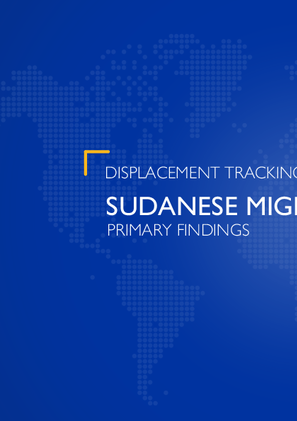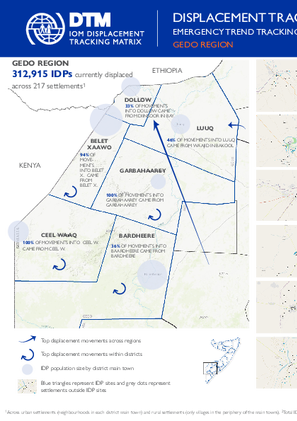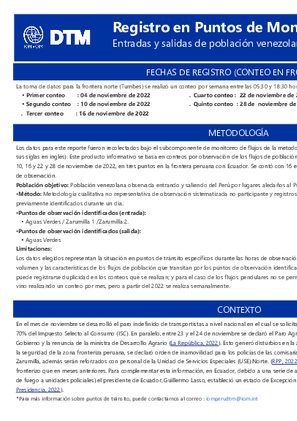-
Countries
-
Data and Analysis
-
Special Focus
-
Crisis Responses
Contact
DTMUkraine@iom.int
Location
Ukraine
Activity
- Mobility Tracking
- Baseline Assessment
Period Covered
Jan 01 2023 -Jan 31 2023
A baseline assessment is a sub-component of mobility tracking. It aims to collect data on IDP, migrant or returnee population presence in a defined administrative area of the country.
Population Groups
IDPs
Survey Methodology
Unit of Analysis Or Observation
Admin Area 2
Type of Survey or Assessment
Key Informant
Keywords
Geographical Scope Partial Coverage
Administrative boundaries with available data
The current dataset covers the following administrative boundaries

Contact
DTM Yemen, iomyemendtm@iom.int
Language
English
Location
Yemen
Period Covered
Jan 29 2023
Feb 04 2023
Activity
- Rapid Emergency Registration
- Mobility Tracking
IOM Yemen DTM’s Rapid Displacement Tracking (RDT) tool collects data on estimated numbers of households forced to flee on a daily basis from their locations of origin or displacement, allowing for regular reporting of new displacements in terms of estimated numbers, geography, and needs. It also tracks returnees who returned to their location of origin.
From 1 January to 4 February 2023, IOM Yemen DTM tracked 1,068 households (HH) (6,408 Individuals) who experienced displacement at least once.
Between 29 January and 4 February 2023, IOM Yemen DTM tracked 66 households (396 individuals) displaced at least once. The majority of people moved into/within the following governorates and districts:
- Marib (40 HHs) – Marib City (29 HHs), Marib (8 HHs), Harib (3 HHs) districts. Most displacements in the governorate originated from Marib and Al Hodeidah.
- Al Hodeidah (15 HHs) – Hays (15 HHs) district. Most displacements in the governorate originated from Taiz and Al Hodeidah.
- Shabwah (8 HHs) – Bayhan (5 HHs), Radum (3 HHs) districts. Most displacements in the governorate originated from Al Bayda and Al Hodeidah.
The majority of people moved from the following governorates and districts:
- Al Hodeidah (17 HHs) – Jabal Ras (5 HHs), Al Jarrahi (3 HHs), Hays (3 HHs) districts.
- Taiz (12 HHs) – Maqbanah (10 HHs), At Taiziyah (1 HH), Mawiyah (1 HH) districts.
- Marib (10 HHs) – Harib (3 HHs), Jabal Murad (3 HHs), Sirwah (2 HHs) districts.
Contact
DTM Yemen, iomyemendtm@iom.int
Location
Yemen
Activity
- Mobility Tracking
- Event Tracking
Period Covered
Jan 29 2023 -Feb 04 2023
From 1 January to 4 February 2023, IOM Yemen DTM tracked 1,068 households (HH) (6,408 Individuals) who experienced displacement at least once.
Between 29 January and 4 February 2023, IOM Yemen DTM tracked 66 households (396 individuals) displaced at least once. The majority of people moved into/within the following governorates and districts:
- Marib (40 HHs) – Marib City (29 HHs), Marib (8 HHs), Harib (3 HHs) districts. Most displacements in the governorate originated from Marib and Al Hodeidah.
- Al Hodeidah (15 HHs) – Hays (15 HHs) district. Most displacements in the governorate originated from Taiz and Al Hodeidah.
- Shabwah (8 HHs) – Bayhan (5 HHs), Radum (3 HHs) districts. Most displacements in the governorate originated from Al Bayda and Al Hodeidah.
- Al Hodeidah (17 HHs) – Jabal Ras (5 HHs), Al Jarrahi (3 HHs), Hays (3 HHs) districts.
- Taiz (12 HHs) – Maqbanah (10 HHs), At Taiziyah (1 HH), Mawiyah (1 HH) districts.
- Marib (10 HHs) – Harib (3 HHs), Jabal Murad (3 HHs), Sirwah (2 HHs) districts.
Population Groups
Survey Methodology
Unit of Analysis Or Observation
Type of Survey or Assessment
Keywords
Geographical Scope
Administrative boundaries with available data
The current dataset covers the following administrative boundaries

Contact
Niger Migration Data and Research Unit - nigerdataresearch@iom.int
Language
English
Location
Niger
Period Covered
Aug 01 2022
Aug 31 2022
Activity
- Survey
The complex crisis in the Liptako Gourma region of the Central Sahel, spanning Burkina Faso, Mali, and Niger, continues to experience insecurity that triggered significant population displacement in the three bordering countries. In Niger, the volatile security situation critically impacted the stability of communities in the regions of Tahoua and Tillaberi, creating a complex humanitarian emergency marked by violence from non-state armed groups (NSAGs), lack of livelihood opportunities and communal tensions over scarce resources exacerbated by climate change. The protracted crisis propelled thousands of internally displaced persons (IDPs) and refugees from border countries. Despite the deterioration of the security situation, there is evidence that some IDPs are returning to their communities of origin. As such, humanitarian and development interventions targeting conflict-affected communities remains vital. In order to find durable solutions for internal displacement — whether through return to communities of origin, local integration, or relocation — and to prevent new displacements in the region, it is critical to understand the relative levels of stability in locations hosting returnees or displaced populations. Therefore, IOM has launched the Stability Index (SI) to evaluate the stability of areas hosting returnees or displaced populations. The SI seeks to understand which factors influence a location's stability, which can inform priority programmatic interventions along the humanitarian, peace and development nexus in order to strengthen the resilience and stability and prevent future forced displacements. This report presents the results of Stability Index assessments in Tahoua and Tillaberi regions of Niger.

Contact
Niger Migration Data and Research Unit - nigerdataresearch@iom.int
Language
French
Location
Niger
Period Covered
Aug 01 2022
Aug 31 2022
Activity
- Survey
Des milliers de personnes ont été déplacées dans la région du bassin du lac Tchad en raison du conflit armé et des incursions constantes de groupes armés non étatiques dans le nord du Cameroun, la province des lacs du Tchad, le Niger et le nord-est du Nigeria. Depuis 2013, la région de Diffa au Niger a été confrontée à des déplacements de population considérables à l'intérieur de ses frontières et accueille des rapatriés et des réfugiés en provenance du nord-est du Nigeria. Il est essentiel de comprendre les niveaux relatifs de stabilité dans les lieux accueillant des rapatriés ou des populations déplacées afin de trouver des solutions durables aux déplacements internes - que ce soit par le biais d'un retour dans les communautés d'origine, d'une intégration locale ou d'une relocalisation - et de prévenir de nouveaux déplacements dans la région. L’indice de stabilité (IS) a été lancé par l’OIM afin d'évaluer la stabilité des zones accueillant des rapatriés ou des populations déplacées. L'indice de stabilité cherche à comprendre les facteurs qui influencent la stabilité d'un lieu, ce qui peut informer les interventions programmatiques prioritaires le long du lien entre l'humanitaire, la paix et le développement, afin de renforcer la résilience et la stabilité et de prévenir de futurs déplacements forcés. Ce rapport présente les résultats du troisième cycle de l'indice de stabilité réalisé en août-septembre 2022 dans la région de Diffa au Niger.

Contact
dtmsudan@iom.int
Language
English
Location
Sudan
Snapshot Date
Nov 30 2022
Activity
- Survey
In July 2022, DTM Sudan designed and implemented a migration survey assessing the migration patterns of Sudanese households across 18 states, interviewing a total of nearly 17,000 households.
The rationale of this survey was to provide best estimates of recent migration of Sudanese nationals, as well as gauging the intentions, plans, and pathways of this migrant population.
Contact
ISSDTM@iom.int; dhilaire@iom.int
Location
South Sudan
Activity
- Mobility Tracking
Period Covered
Jan 01 2022 -Dec 31 2022
IOM DTM employs Event Tracking as a more rapid and localized assessment tool complementing overall efforts to report on IDP and returnee figures nationally. IOM teams access IDP/returnee locations and consult local key informants including community representatives, local authorities or humanitarian partners and triangulate findings to provide partners with the most accurate as possible, actionable and current data.
Population Groups
Survey Methodology
Unit of Analysis Or Observation
Type of Survey or Assessment
Keywords
Geographical Scope
Administrative boundaries with available data
The current dataset covers the following administrative boundaries
Contact
DTM Haiti, DTMHaiti@iom.int
Location
Haiti
Activity
- Mobility Tracking
- Baseline Assessment
Period Covered
Oct 25 2022 -Nov 23 2022
A baseline assessment is a sub-component of mobility tracking. It aims to collect data on IDP, migrant or returnee population presence in a defined administrative area of the country.
Population Groups
Survey Methodology
Unit of Analysis Or Observation
Type of Survey or Assessment
Keywords
Geographical Scope
Administrative boundaries with available data
The current dataset covers the following administrative boundaries

Contact
DTM Somalia, IOMSomaliaDTM@iom.int
Language
English
Location
Somalia
Period Covered
Jan 14 2023
Jan 18 2023
Activity
- Mobility Tracking
- Event Tracking
There are 312,915 individuals currently displaced by drought in Gedo region. Since round 45, an estimated 4,301 IDPs arrived at the assessed settlements.

Contact
DTM Peru, IOMDTMPeru@iom.int
Language
English
Location
Peru
Period Covered
Nov 04 2022
Nov 16 2022
Activity
- Flow Monitoring
En el mes de noviembre se desarrolló el paro indefinido de transportistas a nivel nacional en el cual se solicitaba la regulación del precio del combustible y la devolución del 70% del Impuesto Selecto al Consumo (ISC). En paralelo, entre 23 y el 24 de noviembre se declaró el Paro Agrario solicitando la compra de fertilizantes por parte del Gobierno y la renuncia de la ministra de Desarrollo Agrario (La República, 2022). Esto generó disturbios en la zona norte del país, para lo cual, con la intención de garantizar la seguridad de la zona fronteriza peruana, se declaró orden de inamovilidad para los policías de las comisarías de Aguas Verdes, Zarumilla y Papayal en la provincia de Zarumilla, además serán reforzados con personal de la Unidad de Servicios Especiales (USE) Norte. (RPP, 2022). Como consecuencia de ello, existe un mayor control fronterizo que en meses anteriores. Para complementar esta información, en Ecuador, debido a una serie de atentado (detonaciones de coches bomba, ataques con armas de fuego a unidades policiales) el presidente de Ecuador, Guillermo Lasso, estableció un estado de Excepción y toque de queda (Secretaría General de Comunicación de la Presidencia, 2022).
